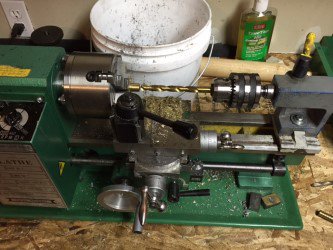So a little back story, because maybe its operator error and not the tooling (but that's never the case...right?)
I was using my little Central machinery 7x10 to bore out a 5/8" brass rod that is just over 9" long. ( I would indicate to 0, face/ bore half, flip it around, then indicate, and bore the other half). I started by facing the end I was going to work with. I started using some of the cemented tooling that i got with the lathe, but they were leaving an awful finish. I assume because they are not sharp. I switched to 3/8" index-able carbide and ramped up the RPM, and fed the tooling faster than usual, and it got better. I ground down the rake on the drill bit i was using (the best I can with the stones I have). However, I did this after I was done with the first half. I pulled the piece from the chuck and noticed the rod was now bent!!! That seems like a HUGE amount of force occurring in there. What did I do wrong?
Anyways my original question. When grinding tools for brass you want 0 top rake. Can I get away with just grinding one set of tools that are designed for brass turning, but still use them for steels and aluminum? I ask because I have limited space in my "shop".
I was using my little Central machinery 7x10 to bore out a 5/8" brass rod that is just over 9" long. ( I would indicate to 0, face/ bore half, flip it around, then indicate, and bore the other half). I started by facing the end I was going to work with. I started using some of the cemented tooling that i got with the lathe, but they were leaving an awful finish. I assume because they are not sharp. I switched to 3/8" index-able carbide and ramped up the RPM, and fed the tooling faster than usual, and it got better. I ground down the rake on the drill bit i was using (the best I can with the stones I have). However, I did this after I was done with the first half. I pulled the piece from the chuck and noticed the rod was now bent!!! That seems like a HUGE amount of force occurring in there. What did I do wrong?
Anyways my original question. When grinding tools for brass you want 0 top rake. Can I get away with just grinding one set of tools that are designed for brass turning, but still use them for steels and aluminum? I ask because I have limited space in my "shop".


